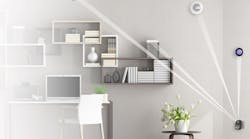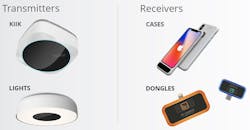The following article was originally published in eeNews Europe.
Nowadays, when you speak about wireless charging, you immediately think about either inductive coupling as it is implemented in charging mats or RF-based solutions as demonstrated by the like of Powercast or Energous. But Wi-Charge claims its solution is both safer (radiation-free, interference-free) and more energy efficient, since a precisely focused infrared laser beam is all what it takes to transfer power between a charging hotspot and client devices equipped with an add-on photovoltaic cell.
Reached by eeNews Europe, Wi-Charge's Co-Founder and CEO Victor Vaisleib accepted to share more about the technology and his company's business roadmap.
"The term 'wireless power' is used for a very broad range of different solutions without pointing out particular benefits for the users", acknowledges Vaisleib, "we like to describe what we offer as 'autonomous charging', that is, recharging devices without any user intervention.
At CES in Las Vegas, Israeli startup Wi-Charge unveiled the first ever solution of room lighting combined with wireless charging, designed for a café environment. The FDA-approved solution, dubbed LIGHT, can deliver up to 2.5W of power at a distance of up to 5 meters, simultaneously recharging a number of mobile and multimedia battery-powered applications across a room, totaling up to 50 Wh/day.
According to the CEO, to be practical, a wireless power infrastructure needs to be able to deliver sufficient power over a sufficient distance, without asking users to get their devices to a specific power charger or to a charging mat. Components also need to be small. Wi-Charge says it complies with all these requirements, being much more efficient than other long-distance RF-based wireless charging solutions.
Appreciating the physics of wireless charging, Vaisleib notes, "Sending energy over a distance, a beam always diverges, which is a bad thing as too little power is going in the right direction, and too much power splits and goes elsewhere. With RF, only relatively humble distances can be achieved, with a power capacity about a fraction of a Watt, limited by the maximum level of exposure allowed for safety. Shorter wavelength beams maintain their integrity better. With an infrared laser, we have a practically non-diverging beam able to deliver its entire power content onto a small receiver".
Trying to establish energy efficiency comparisons with the likes of Powercast or Energous proves difficult since manufacturers never publish their specs. But proceeding to a succinct reverse engineering from bits of information found in a recent FCC filing from Energous, Vaisleib's theoretical analysis yields that a 10W transmitter would deliver about 0.1 W of power at a distance of about 75 cm.
"Even with an ideal hardware implementation, a simple analysis of RF beam propagation in air points to inefficiency, without even considering hardware power conversion inefficiencies" the CEO says.
"With ultrasound, you get a few percentages of the initial power reaching the target device, for RF, you get only a fraction of a percent. Everything I have spotted on public reports agrees with that. If RF worked, we'd be happy to work with it. The fundamental idea to adopt infrared was not a quick process, we had it more than five years in development," Vaisleib told us during a phone interview.
In stark contrast, the company says it can deliver several watts of power over distances up to 10 meters, with very small components, offering a solution that can be readily deployed as a wireless charging infrastructure.
A wall-plug transmitter beams out power to different devices.
So, what's in a transmitter, and how does a transmitter precisely identify and target devices to be charged in a room? We asked.
"For aiming, as in all laser-based technologies or projectors, nothing beats micro-mirrors. They are the most cost-effective way to aim a laser, and depending on the application we can multiplex beams or use different mirrors or both. For larger devices such as smartphones, we may focus a single beam whereas for smaller devices such as sensors or webcams, we can use one beam sequentially polled to multiple devices" revealed Vaisleib.
As for the identification and acquisition of targets, the CEO explained that each target receiver blinks back with a particular pattern that allows the transmitter to discriminate the power needs of individual receivers. Built into the power transmitter, arrays of pin-diodes are arranged to triangulate and locate the different sources of signal, mapping the receivers in the room so they can be targeted with appropriate power levels.
But you need an add-on receiver including the photovoltaic cell, and it could take some time to convince end-users to buy into this sort of infrastructure, we objected.
"Partners are approaching us to integrate our solution into all types of smart devices, for the wireless delivery of power to wireless cameras, door locks, smart speakers and other devices that are not yet as widespread as smartphones and whose adoption is stalled by battery life" the CEO answered.
"We see OEMs come to us to integrate the wireless power receivers into their devices with a wireless power supply that could be a wall-plug transmitter beaming out to different devices" he added.
First, the company wants to extend its wireless power infrastructure through B2B partnerships in corporate offices, or public places such as coffee shops and restaurants, where the receivers could be integrated into different form factors. That could be smartphone cases or dongles for customers to use. Interestingly, one practical example Vaisleib gave us was that of wireless charging mats. In order to be integrated into furniture, those need to be wired. But typically in coffee shops and restaurants, about 70 to 75% of actual seating area and tables is free standing, meaning they can't be wired easily. But you could have ceiling-mounted transmitters beaming their power to charging mats integrated into cable-free furniture.
Shown are different implementations of Wi-Charge's transmitters and receivers.
"We are not announcing partnerships yet, but we are engaged with several manufacturers. After a number of years, once we have built an infrastructure, we see a mixture of business models. Selling the hardware may not be the best of them. We could offer monthly subscriptions for maintenance and upgrades, in some business models, we may retain ownership of the hardware and collect valuable data".
"With a map of our infrastructure, we could tip people where to go to charge their phone. The data collected would be subordinated to the needs of customers. We can tell if your battery has depleted by 40%, end-users could decide what kind of profile charge they want for their battery so it can last longer".
With such an infrastructure, mobile operators may want to offer tier services only to their subscribers, for example offering fast charging to one type of subscriber or less charge top-up to others. A coffee shop or restaurant could operate specific charge restrictions per table or per customers based on loyalty programs. Power delivery could be completely software-configurable, so a casino operator could want to provide only trickle charge to its customers, so they would stay longer.
Of course, integration with luminaires is an obvious choice in the long term and eventually the company wants to go that route.
"It fits well with what we do and many lighting manufacturers come to us with that request", agreed the CEO, "but the technology needs to mature a bit, it needs to be accepted by customers before we can target consumers directly. That's why the first transmitter we showed at CES was in a bulb form factor with LEDs, acknowledging the potential for luminaire integration".
Asked if the laser beam from the power transmitter could also serve to encode data for light communication (LiFi-style), Vaisleib doesn't want to confuse potential partners.
"If you look at our early patents, we also patented data connection with those links, and technically, this possibility exists, but commercially, we never found it beneficial as for now it is still way inferior to radio links".
If LiFi became mainstream in 20 years from now, then surely Wi-Charge could integrate it, but for now it considers the application too niche.
On its webpage, the company envisions the proliferation of remote charging hotspots in homes, offices and in public areas in a way similar to the adoption of WiFi, freeing mobile devices from all cable connections. It lists in its product catalogue several types of power transmitters, with power delivery capacities ranging from 500 mW from a 137 × 137 × 59 mm unit to 2,500 mW for the LED luminaire version.
Check out this video on the technology:




